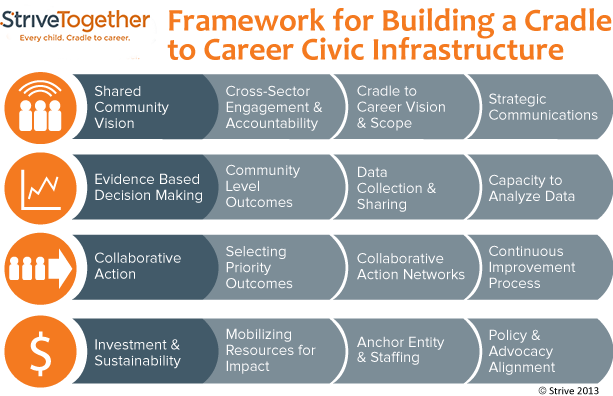Now a transformative movement in the social sector, a Stanford Social Innovation Review article first introduced the concept of “Collective Impact.” This is the idea that substantially more remarkable progress could be made in alleviating many of our most serious and complex social problems if nonprofits, governments, businesses, and the public were brought together around a common agenda to create a collective impact. Meanwhile, the social sector remains focused on the isolated intervention of individual organizations.
However, collective Impact is more rigorous and specific than simple collaboration among organizations. There are five conditions that, together, lead to meaningful results from Collective Impact:
- Common Agenda: All participants have a shared vision for change, including a common understanding of the problem and a joint approach to solving it through agreed-upon actions.
- Shared Measurement: Collecting data and measuring results consistently across all participants ensures efforts remain aligned and participants hold each other accountable.
- Mutually Reinforcing Activities: Participant activities must be differentiated while still being coordinated through a mutually reinforcing action plan.
- Continuous Communication: Consistent and open communication is needed across players to build trust, assure mutual objectives, and appreciate common motivation.
- Backbone Organization: Creating and managing collective Impact requires a separate organization(s) with staff and a specific set of skills to serve as the backbone for the entire initiative and coordinate participating organizations and agencies
StriveTogether in Cincinnati is a good example of Collective Impact in action. Building upon lessons learned across over 90 Network members, StriveTogether has developed a framework for creating the Cradle Career Civic Infrastructure. The Cradle to Career Civic Infrastructure is not a program but a way in which a community comes together around a Cradle to Career vision and organizes itself to identify what gets results for children, improves and builds upon those efforts over time, and invests the community’s resources differently to increase Impact.

Recognizing that many practitioners lack the resources and connections they need to be successful in this work, FSG and the Aspen Institute Forum for Community Solutions recently announced the Collective Impact Forum. This forum will be a resource for practitioners and funders using the collective impact approach to achieve large-scale systems change. Sign up to receive notifications when the online community launches.
The Collective Impact concept has themes similar to those in our blog on the Six Practices of High-Impact Nonprofits. Transform Consulting Group also sees Collective Impact in play when funders seek a community-based approach to projects, such as with the 21st Century Community Learning Centers Grant. Transform Consulting Group can help your organization identify community partners, establish outcomes and evaluation systems, and diversify funding for a sustained impact. Want to know more? Contact Transform Consulting Group today for a free consultation!
